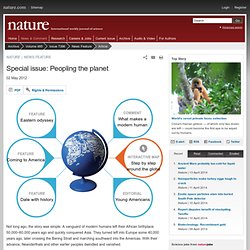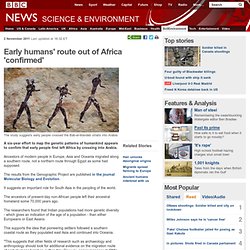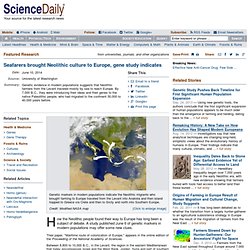

Sahul Time - Monash University. Special issue: Peopling the planet. Not long ago, the story was simple.

A vanguard of modern humans left their African birthplace 50,000–60,000 years ago and quickly conquered Asia. They turned left into Europe some 40,000 years ago, later crossing the Bering Strait and marching southward into the Americas. With their advance, Neanderthals and other earlier peoples dwindled and vanished. But in the past five years, the picture has grown more complex — and more interesting.
Few question the idea that modern humans are all emigrants from Africa. Early humans' route out of Africa 'confirmed' 2 November 2011Last updated at 16:32 ET The study suggests early people crossed the Bab-el-Mandeb straits into Arabia A six-year effort to map the genetic patterns of humankind appears to confirm that early people first left Africa by crossing into Arabia.

Ancestors of modern people in Europe, Asia and Oceania migrated along a southern route, not a northern route through Egypt as some had supposed. The results from the Genographic Project are published in the journal Molecular Biology and Evolution. It suggests an important role for South Asia in the peopling of the world. The ancestors of present-day non-African people left their ancestral homeland some 70,000 years ago. The researchers found that Indian populations had more genetic diversity - which gives an indication of the age of a population - than either Europeans or East Asians. This supports the idea that pioneering settlers followed a southern coastal route as they populated east Asia and continued into Oceania. Seafarers brought Neolithic culture to Europe, gene study indicates. How the Neolithic people found their way to Europe has long been a subject of debate.

A study published June 6 of genetic markers in modern populations may offer some new clues. Their paper, "Maritime route of colonization of Europe," appears in the online edition of the Proceeding of the National Academy of Sciences. Between 8,800 to 10,000 B.C., in the Levant, the region in the eastern Mediterranean that today encompasses Israel and the West Bank, Jordan, Syria and part of southern Turkey, people learned how to domesticate wild grains.
This accomplishment eventually allowed them to abandon their lives as nomadic hunter-gathers and become farmers. Archeologists use this transition from hunter-gathering to farming to mark the end of the Paleolithic era, or Old Stone Age, and the beginning of the Neolithic era, or New Stone age. Archeological evidence indicates that by 7,000 B.C. Deep sea fishing for tuna began 42,000 years ago - life - 24 November 2011. Tuna has been on the menu for a lot longer than we thought.

Even 42,000 years ago, the deep-sea dweller wasn't safe from fishing tackle according to new finds in southeast Asia. We know that open water was no barrier to travel in the Pleistocene – humans must have crossed hundreds of kilometres of ocean to reach Australia by 50,000 years ago. But while humans had already been pulling shellfish out of the shallows for 100,000 years by that point, the first good evidence of fishing with hooks or spears comes much later – around 12,000 years ago. The new finds blow that record out of the water. Sue O'Connor at the Australian National University in Canberra and colleagues dug through deposits at the Jerimalai shelter in East Timor.
Amidst the fishy debris was a broken fish hook fashioned from shell, which the team dated to between 16,000 and 23,000 years. East Timor hosts few large land animals, so early occupants would have needed highly developed fishing skills to survive. Promoted Stories. Sahul Time - Monash University. Toba catastrophe theory. The Toba supereruption was a supervolcanic eruption that occurred some time between 69,000 and 77,000 years ago at the site of present-day Lake Toba (Sumatra, Indonesia).

It is one of the Earth's largest known eruptions. The Toba catastrophe hypothesis holds that this event caused a global volcanic winter of 6–10 years and possibly a 1,000-year-long cooling episode. The Toba event is the most closely studied super-eruption.[2][3][4] In 1993, science journalist Ann Gibbons suggested a link between the eruption and a bottleneck in human evolution, and Michael R. Timeline. Fertile Crescent. The Fertile Crescent at maximum defined extent, with the names of ancient civilizations found there.

The Fertile Crescent is a crescent-shaped region containing the comparatively moist and fertile land of otherwise arid and semi-arid Western Asia, and the Nile Valley and Nile Delta of northeast Africa. The term was popularized by University of Chicago archaeologist James Henry Breasted. Human Evolution Timeline Interactive. Timeline. Timeline.